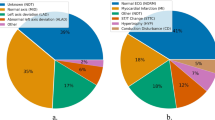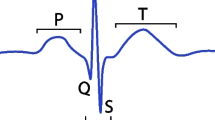Abstract
The Electrocardiogram (ECG) test is instrumental in daily clinical practice. It comprises the signal from different leads jointly analyzed by the cardiologist to conclude the diagnosis. However, the complete set of ECG signals needs to be collected in a clinical environment with the help of professionals and appropriate equipment. With the emergence of smartwatches, users can perform the ECG test more comfortably and easily. Although collecting one lead at a time is possible, more is needed for a complete clinical analysis. Some works sought to facilitate obtaining the ECG test by reconstructing a set of leads from a smaller set. Most works start from more than one lead, and others have also carried out this reconstruction from a single lead, but with restrictions like considering aligned segments of a single beat or segments of fixed length. The present work achieved the best results in the literature for reconstructing several of the 11 leads from lead I, considering segments without fixed size. These results were possible through a neural network architecture for the direct conversion (point-by-point) of ECG leads, with the following advantages over other alternatives: the possibility of being trained with signal segments of different sampling frequencies and durations without changing the architecture, complexity adjustment to avoid overfitting on small datasets and ability to deal with raw data. Our architecture achieved the average value of Pearson correlation of 0.75 on a cross-database evaluation against the current value of 0.39.
Access this chapter
Tax calculation will be finalised at checkout
Purchases are for personal use only
Similar content being viewed by others
References
Abdou, A., Krishnan, S.: Horizons in single-lead ECG analysis from devices to data. Front. Sig. Process. 2 (2022). https://doi.org/10.3389/frsip.2022.866047
Beco, S.C., Pinto, J.R., Cardoso, J.S.: Electrocardiogram lead conversion from single-lead blindly-segmented signals. BMC Med. Inf. Decis. Mak. 22(1) (2022). https://doi.org/10.1186/s12911-022-02063-6
Bousseljot, R., Kreiseler, D., Schnabel, A.: Nutzung der ekg-signaldatenbank cardiodat der ptb über das internet. Biomed. Eng. 40(s1), 317–318 (1995). https://doi.org/10.1515/bmte.1995.40.s1.317
Drew, B.J., et al.: Prevention of torsade de pointes in hospital settings. Circulation 121(8), 1047–1060 (2010). https://doi.org/10.1161/CIRCULATIONAHA.109.192704
Golany, T., Radinsky, K.: PGANs: personalized generative adversarial networks for ECG synthesis to improve patient-specific deep ECG classification. In: Proceedings of the AAAI Conference on Artificial Intelligence, vol. 33, no. 1, pp. 557–564 (2019)
Goldberger, E.: The aVl, aVr, and aVf leads: a simplification of standard lead electrocardiography. Am. Heart J. 24(3), 378–396 (1942). https://doi.org/10.1016/S0002-8703(42)90821-4
Grande-Fidalgo, A., Calpe, J., Redón, M., Millán-Navarro, C., Soria-Olivas, E.: Lead reconstruction using artificial neural networks for ambulatory ECG acquisition. Sensors 21(16), 5542 (2021). https://doi.org/10.3390/s21165542
Ilg, K.J., Lehmann, M.H.: Importance of recognizing pseudo-septal infarction due to electrocardiographic lead misplacement. Am. J. Med. 125(1), 23–27 (2011)
Lan, E.: Performer: a novel PPG-to-ECG reconstruction transformer for a digital biomarker of cardiovascular disease detection. In: 2023 IEEE/CVF Winter Conference on Applications of Computer Vision (WACV), pp. 1990–1998. IEEE Computer Society, Los Alamitos, CA, USA (2023). https://doi.org/10.1109/WACV56688.2023.00203
Lee, J., Oh, K., Kim, B., Yoo, S.K.: Synthesis of electrocardiogram V-lead signals from limb-lead measurement using R-peak aligned generative adversarial network. IEEE J. Biomed. Health Inform. 24(5), 1265–1275 (2020). https://doi.org/10.1109/JBHI.2019.2936583
Malmivuo, J., Plonsey, R.: Bioelectromagnetism. 16. Vectorcardiographic Lead Systems, pp. 290–306 (1995)
Mohammed, W.R., Hussein, A.F.: The optimization of ECG-leads based cardiovascular abnormal detection scheme. In: 2022 2nd International Conference on Computing and Machine Intelligence (ICMI), pp. 1–5 (2022). https://doi.org/10.1109/ICMI55296.2022.9873695
Nguyen, Q.H., Nguyen, B.P., Nguyen, T.B., Do, T.T., Mbinta, J.F., Simpson, C.R.: Stacking segment-based CNN with SVM for recognition of atrial fibrillation from single-lead ECG recordings. Biomed. Sig. Process. Control 68, 102672 (2021). https://doi.org/10.1016/j.bspc.2021.102672
van den Oord, A., et al.: WaveNet: a generative model for raw audio. arXiv preprint arXiv:1609.03499 (2016)
Ronneberger, O., Fischer, P., Brox, T.: U-Net: convolutional networks for biomedical image segmentation. In: Navab, N., Hornegger, J., Wells, W.M., Frangi, A.F. (eds.) MICCAI 2015. LNCS, vol. 9351, pp. 234–241. Springer, Cham (2015). https://doi.org/10.1007/978-3-319-24574-4_28
Sohn, J., Yang, S., Lee, J., Ku, Y., Kim, H.C.: Reconstruction of 12-lead electrocardiogram from a three-lead patch-type device using a LSTM network. Sensors 20(11), 3278 (2020). https://doi.org/10.3390/s20113278
Tung, R.T.: Electrocardiographic limb leads placement and its clinical implication. Kansas J. Med. 14(3), 229–230 (2021). https://doi.org/10.17161/kjm.vol14.15259
Wagner, P., et al.: PTB-XL, a large publicly available electrocardiography dataset. Sci. Data 7(1), 154 (2020). https://doi.org/10.1038/s41597-020-0495-6
Waller, A.D.: A demonstration on man of electromotive changes accompanying the heart’s beat. J. Physiol. 8(5), 229–234 (1887)
Yang, H., Bukkapatnam, S.T., Komanduri, R.: Spatiotemporal representation of cardiac vectorcardiogram (VCG) signals. Biomed. Eng. Online 11, 1–15 (2012). https://doi.org/10.1186/1475-925X-11-16
Zeisler, E.B.: A critique of Einthoven’s law in electrocardiography. Proc. Soc. Exp. Biol. Med. 28, 12–15 (1930)
Acknowledgements
Part of the results presented in this article were carried out within the scope of the project “CENTRO DE EXCELENCIA EM INTELIGENCIA ARTIFICIAL - AI4WELLNESS” which is funded by Samsung Eletronica da Amazonia Ltda, under terms of Brazilian Federal Law No. 8,248/1991. The authors thank the contribution of the research team who provided feedback on this study and supported this work.
Author information
Authors and Affiliations
Corresponding author
Editor information
Editors and Affiliations
Rights and permissions
Copyright information
© 2025 The Author(s), under exclusive license to Springer Nature Switzerland AG
About this paper
Cite this paper
Chaves, S.B., Macedo, J.A.F.d., Magalhães, R.P., Cruz, L.A., Batista, B.R.M. (2025). Direct One-to-All Lead Conversion on 12-Lead Electrocardiogram. In: Meo, R., Silvestri, F. (eds) Machine Learning and Principles and Practice of Knowledge Discovery in Databases. ECML PKDD 2023. Communications in Computer and Information Science, vol 2136. Springer, Cham. https://doi.org/10.1007/978-3-031-74640-6_3
Download citation
DOI: https://doi.org/10.1007/978-3-031-74640-6_3
Published:
Publisher Name: Springer, Cham
Print ISBN: 978-3-031-74639-0
Online ISBN: 978-3-031-74640-6
eBook Packages: Artificial Intelligence (R0)




